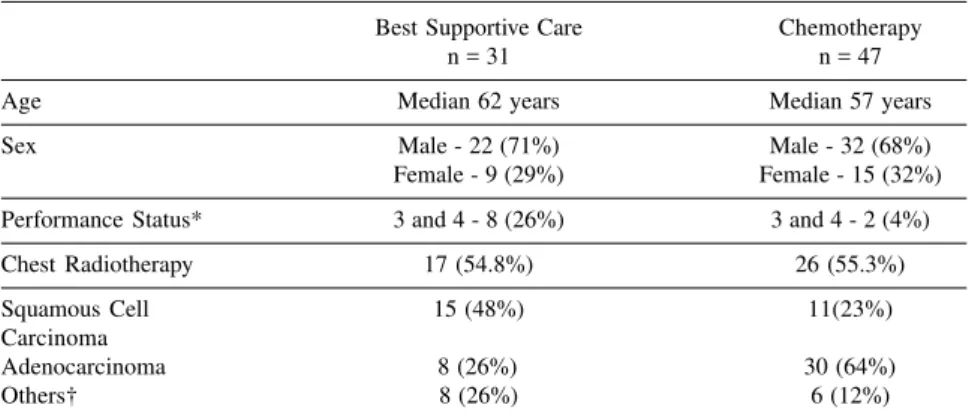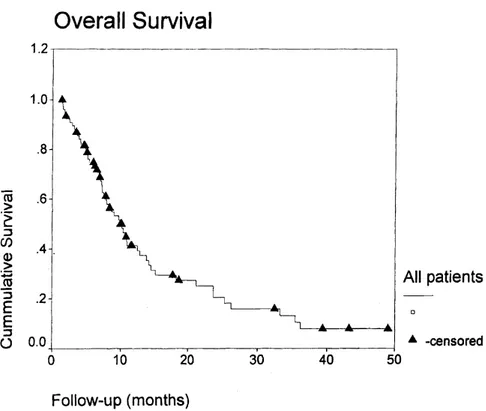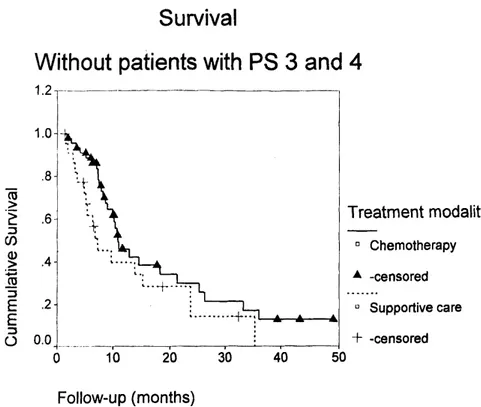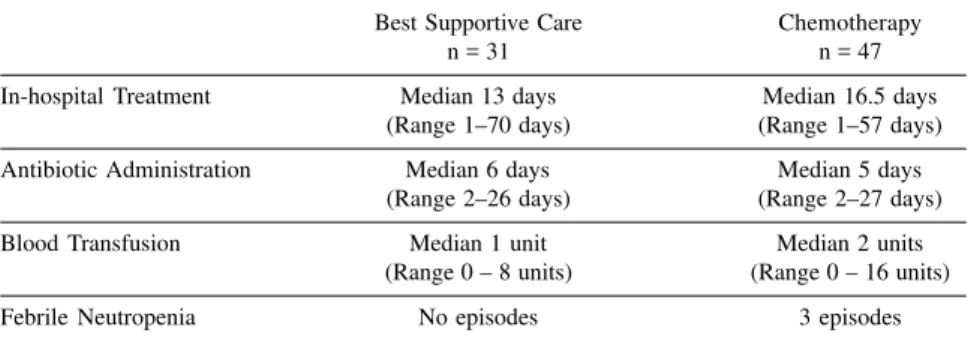From the Departments of Clinical Oncology, Thoracic Surgery and Radiation Oncology -Hospital do Câncer, Fundação Antônio Prudente.
CHEMOTHERAPY VERSUS BEST SUPPORTIVE
CARE IN STAGE IV NON-SMALL CELL LUNG
CANCER, NON METASTATIC TO THE BRAIN
Agnaldo Anelli, Candice A. A. Lima, Riad N. Younes, Jefferson L. Gross and Ricardo Fogarolli
RHCFAP/3036
ANELLI A et al. -Chemotherapy versus best supportive care in stage IV non-small cell lung cancer, non metastatic to the brain.
Rev. Hosp. Clín. Fac. Med. S. Paulo 56(2):53-58, 2001.
Stage IV non-small cell lung cancer is a fatal disease, with a median survival of 14 months. Systemic chemotherapy is the most common approach. However the impact in overall survival and quality of life still a controversy.
Objectives: To determine differences in overall survival and quality of life among patients with stage IV non-small cell lung cancer non-metastatic to the brain treated with best supportive care versus systemic chemotherapy.
Patients: From February 1990 through December 1995, 78 eligible patients were admitted with the diagnosis of stage IV
non-small cell lung cancer . Patients were divided in 2 groups: Group A (n=31 – treated with best supportive care ), and Group B (n=47 – treated with systemic chemotherapy).
Results: The median survival time was 23 weeks (range 5 – 153 weeks) in Group A and 55 weeks (range 7.4 – 213 weeks) in
Group B (p=0.0018). In both groups, the incidence of admission for IV antibiotics and need of blood transfusions were similar. Patients receiving systemic chemotherapy were also stratified into those receiving mytomycin, vinblastin, and cisplatinum, n=25 and those receiving other combination regimens (platinum derivatives associated with other drugs, n=22). Patients receiving mytomycin, vinblastin, and cisplatinum, n=25 had a higher incidence of febrile neutropenia and had their cycles delayed for longer periods of time than the other group. These patients also had a shorter median survival time (51 versus 66 weeks, p=0.005).
Conclusion: In patients with stage IV non-small cell lung cancer, non-metastatic to the brain, chemotherapy significantly increases survival compared with best supportive care.
DESCRIPTORS: Chemotherapy. Non-small cell lung cancer. Best supportive care. Mytomycim, vinblastin and cisplatinum. Fatal disease.
Non-small cell lung carcinoma (NSCLC) is a common tumor, with ap-proximately half a million new cases registered every year worldwide1.
Thirty to 40% of all newly admitted patients present with disseminated metastatic disease with a limited or pal-liative role for localized surgical or ra-diation therapy. For patients with this advanced stage, chemotherapy (CT) is the treatment of choice in most centers. Response rates with most regimens of chemotherapy range between 20% and 30%2. Recently, the introduction of
new agents, such as vinorelbine or the combination of cisplatinum or cisplatinum derivatives with paclitaxel, has resulted in higher response rates, reaching 60% in some series3,4.
Those patients usually present a me-dian survival of 6 months5. The impact
of chemotherapy on overall survival and quality of life of patients with metastatic
NSCLC, as opposed to best supportive care solely, is still widely debated. Sev-eral studies have been published show-ing a small, although statistically sig-nificant, survival advantage for patients treated with chemotherapy6-9.
Meta-analyses and randomized studies10-13
have demonstrated a clear benefit fol-lowing systemic treatment, with one of them reaching a survival advantage of 15 weeks 14.A subsequent study by the
expen-sive regimens were administered15.
Other studies, however, did not report any advantageous trend for chemo-therapy2.
The present study evaluates clinical outcomes of patients with stage IV NSCLC, as well as the impact of dif-ferent treatment modalities.
PATIENTS AND METHODS
A retrospective analysis was per-formed using a prospective database. To obtain a minimum follow-up of 5 years, the records were reviewed from February 1990 to December 1995, with histologically proven stage IV NSCLC and with no demonstrable central ner-vous system metastases on CT scan. The treatment modality of each indi-vidual patient was identified and reg-istered (chemotherapy or best support-ive care), as was the clinical outcome.
Study targets were defined as: 1. Survival analysis for both groups. 2. Assessment of quality of life,
ac-cording to the following criteria: days of in hospital treatment, days of intravenously administered anti-biotics, necessity for blood and blood derivative transfusion, and number of febrile neutropenia epi-sodes.
Eighty-six consecutive patients were admitted during that period, with 8 patients being excluded from the fi-nal afi-nalysis due to loss of follow-up greater than 3 weeks after admission.
Survival time was calculated from the date of diagnosis. Logistic regres-sion was used to adjust for and deter-mine the significance of the effect of prognostic factors in the treatment comparison of response. Cox’s propor-tional hazard model was used to adjust for and determine the significance of the effect of prognostic factors in the treatment comparisons of time to event analyses (survival). All significance levels were two sided16.
RESULTS
Thirty-one patients were treated with best supportive care - BSC (Group A), while 47 patients received chemo-therapy and best supportive care - CT (Group B). Patient characteristics of the two groups are displayed in table 1.
BSC was defined as treatment of pain, cough, dyspnea, palliative radio-therapy, infections, and pleural effu-sions.
Both groups were comparable for age and sex. On the other hand, perfor-mance status was significantly lower in patients of Group A, with 26% of pa-tients presenting with important health problems, compared to 4% in Group B. Patients in Group A more often under-went palliative radiotherapy (n=17 – 54.8%), than patients of Group B (n=26, 55.3%), although the difference was not significant.
Histology was significantly differ-ent between groups: Squamous cell carcinoma was more frequently diag-nosed in Group A, while adenocarci-noma was the most frequent histology in Group B.
Chemotherapy was not indicated in patients of Group A for the following reasons:
1. Palliative radiotherapy (n=9). 2. Patient’s decision (n=5).
3. Medical decision to observe as-ymptomatic patients with ECOG performance status of 3 and 4 (n=8).
4. Infection on admission (n=1). 5. Immediate necessity for palliation
(n=5) until significant symptoms. 6. Limiting comorbidity (cardiac
fail-ure, n=1, renal failfail-ure, n=2).
Median survival for Group A was 23 weeks, significantly lower than the 55 weeks for Group B (p=0.0018). Figure 1 shows the overall survival curve for all patients. Figure 2 shows survival according to modality of treat-ment.
Patients that received chemo-therapy intended to treat metastatic dis-ease were further divided into 2 sub-groups, depending on the regimen used: MVP (mitomycin, vinblastin, and cisplatinum, n=25) considered the stan-dard treatment in the institution at that period, or other investigational chemo-therapy regimens (including cisplatinum derivatives in combination with etoposide or paclitaxel, and the combination of ifosfamide, cisplatinum, and vinblastin, n=22). Pa-tients that received MVP had a 51-week median survival, significantly lower than the 66 weeks for the other group. Figure 3 shows the survival
Table 1 - Patient characteristics.
Best Supportive Care Chemotherapy
n = 31 n = 47
Age Median 62 years Median 57 years
Sex Male - 22 (71%) Male - 32 (68%)
Female - 9 (29%) Female - 15 (32%)
Performance Status* 3 and 4 - 8 (26%) 3 and 4 - 2 (4%)
Chest Radiotherapy 17 (54.8%) 26 (55.3%)
Squamous Cell 15 (48%) 11(23%)
Carcinoma
Adenocarcinoma 8 (26%) 30 (64%)
Others† 8 (26%) 6 (12%)
curves according to the chemotherapy regimen.
The overall response rate for chemo-therapy was 19.1%, with no complete response: nine patients had a partial ob-jective response (19.1%), 21 patients (44.7%) had stable disease, and 17 pa-tients (36.2%) had progressive disease. Figure 4 shows survival curves for pa-tients according to type of response.
Performance status on admission rendered the two groups too heteroge-neous for a meaningful evaluation. However, when patients with ECOG PS 3-4 were excluded from both groups, survival was still significantly greater for patients treated with chemo-therapy (51.2 weeks), compared to the other group (33.8 weeks), p=0.002.
Patients in Group A had a median in-hospital treatment time of 13 days, similar to 16.5 days in Group B. No significant differences were observed for antibiotic administration and trans-fusion episodes. Table 2 displays the corresponding data.
Episodes of neutropenia occurred ex-clusively in MVP patients (n=3 cycles). This chemotherapeutic regimen was as-sociated with significant delays between cycles due to significant toxicity.
DISCUSSION
For patients with non-small cell lung cancer (NSCLC), the prospect of long-term survival is directly related to the surgical resectability of the primary tumor. At initial presentation, the great majority of NSCLC have either locally advanced inoperable disease, stage IV metastatic disease, or comorbid medi-cal conditions that render them unsuit-able for surgical intervention. Because of that, the vast majority of patients with NSCLC are candidates for sys-temic treatment with or without radio-therapy. A large number of clinical tri-als exploring combination chemo-therapy in NSCLC have been per-Figure 1 - Overall survival for all patients.
formed. Several conclusions can be drawn from a review of phase II and phase III randomized trials performed in NSCLC patients15,17,18: (1) overall
re-sponse rates usually range from 20% to 30%; (2) complete responses are an exception; (3) the majority of trials are based on the combination of a cisplatinum derivative and other drugs; (4) the overall impact of combination chemotherapy regimens on improved survival is modest; (5) the majority of patients rarely survive longer than 18 months, and most combination chemo-therapy regimens are associated with some type of toxicity (mainly nausea, vomiting, and febrile neutropenia).
Although most of the trials of che-motherapy in NSCLC show only a mar-ginal improvement in medial length of survival, the majority do show a trend toward improved overall survival when compared with best supportive care (BSC). In a prospective randomized trial conducted by Italian investigators12, 102
patients with NSCLC were randomized to receive a combination of cisplatin, cyclophosphamide, and vinblastin or to receive BSC. In the group of patients re-ceiving chemotherapy, the median over-all survival was 8.5 months versus 4.0 months in the group receiving BSC (p<.0001).
In another randomized trial con-ducted by the National Cancer Institute of Canada13, patients were randomized
to receive two different chemotherapy regimens (vindesin and cisplatin or cy-clophosphamide, doxorubicin, and cisplatin) or BSC. Patients on the che-motherapy arms had a median overall survival of 32.6 and 24.7 weeks re-spectively versus 17 weeks for the group treated with BSC (p=0.05).
However, in two other studies, in-cluding a large randomized trial involv-ing 188 patients, no statistically signifi-cant difference in survival was ob-served, although an advantage for che-motherapy was observed in some patients subsets17,18.
Figure 3 - Survival according to the type of chemotherapy (MVP or other regimens).
Table 2 - Chemotherapy and quality of life.
Best Supportive Care Chemotherapy
n = 31 n = 47
In-hospital Treatment Median 13 days Median 16.5 days
(Range 1–70 days) (Range 1–57 days)
Antibiotic Administration Median 6 days Median 5 days
(Range 2–26 days) (Range 2–27 days)
Blood Transfusion Median 1 unit Median 2 units
(Range 0 – 8 units) (Range 0 – 16 units)
Febrile Neutropenia No episodes 3 episodes
In our study, the median sur-vival for patients receiving BSC was 23 weeks, significantly lower than 55 weeks for the group receiving chemo-therapy (p=0.002). Our data shows that even when patients with a low ECOG performance status are excluded from analysis, overall survival is still higher in patients treated with chemotherapy compared to patients treated with best supportive care only.
Measurement of quality of life remains an important goal for investi-gators treating patients with metastatic lung cancer, since chemotherapy may have a salutary or negative impact in-dependent of how the survival curves look19. In our study, the toxicity in the
group treated with chemotherapy was mild and tolerable. Patients treated with BSC had a median in-hospital treatment time of 13 days, similar to 16.5 days in the group treated with
chemotherapy. We did not observe any significant differences in terms of an-tibiotic administration and transfusion episodes.
The present study, which in-cluded a balanced and adequate num-ber of patients, indicates that patients with metastatic non-small-cell lung cancer can benefit from chemotherapy with a statistically significant increase in survival compared to best support-ive care.
Whether the gains in life expect-ancy are worth potential losses in qual-ity of life from treatment side effects is largely an individual patients choice. The major challenge for oncologists would be to identify and develop prop-erly designed instruments to collect in-formation on how much the expected benefit is valued by the patients and to involve patients in the decision of treat-ment options, reflecting their own pref-erences.
RESUMO RHCFAP/3036
ANELLI A e col. - Quimioterapia versus melhor tratamento de supor-te em câncer de pulmão estádio clí-nico IV não metastático para o sis-tema nervoso central. Rev. Hosp. Clín. Fac. Med. S. Paulo 56
(2):53-58, 2001.
O câncer de pulmão de células não pequenas em estádio IV é uma doença fatal, com uma sobrevida mediana de seis meses. Quimioterapia é a aborda-gem mais freqüente, apresentando um impacto na sobrevida controverso e questionável alteração na qualidade de vida.
Objetivos: Comparar o impacto na
sobrevida global e na qualidade de vida em pacientes portadores de câncer de pulmão de células não pequenas, está-dio IV, tratados com suporte clínico ou quimioterapia.
Pacientes: Entre fevereiro de 1990
e dezembro de 1995, 78 pacientes (pts) portadores de câncer de pulmão de cé-lulas não pequenas estádio IV foram admitidos. Os pacientes foram dividi-dos em dois grupos: grupo A (n=31 – tratados com suporte clínico) e grupo B (n=47, tratados com quimioterapia).
Resultados: A sobrevida mediana no grupo tratado com suporte clínico foi de 23 semanas (variando de 5-153 se-manas) e de 55 semanas no grupo tra-tado com quimioterapia (variando de 7,4 a 213 semanas), p= 0,0018 – Qui-quadrada. Em ambos grupos, a incidên-cia de internações hospitalares para a administração intravenosa de antibióti-cos e hemoderivados foi similar. Paci-entes recebendo quimioterapia, foram estratificados entre àqueles que rece-beram mitomicina, vinblastina e cisplatina, n=25 e àqueles recebendo outros regimes (derivados de platina, associados à outras drogas, n= 22).
Pa-cientes recebendo mitomicina, vinblastina e cisplatina, n=25 apresen-taram uma incidência mais alta de neutropenia febril e tiveram atrasos mais longos entre os ciclos de quimioterapia, quando comparados aos pacientes do outro grupo. Pacientes recebendo mitomicina, vinblastina e cisplatina, n=25, também apresentaram uma pior sobrevida mediana (51 versus 66 sema-nas, p= 0,005 – Qui-quadrado).
Conclusões: Em pacientes com
câncer de pulmão de células não pe-quenas, estádio IV, não metastático para os pulmões, o uso de quimio-terapia aumenta a sobrevida de maneira estatisticamente significativa, quando comparado aos cuidados de suporte.
REFERENCES
1. LANDIS SH, MURRAY T, BOLDEN S et al. - Cancer statistics, 1998. CA. Cancer J Clin 1998; 48:6-29.
2. SHEPHERD FA. - Treatment of advanced non-small cell lung cancer. Semin Oncol1994; 21 [ Suppl. 7]: 7.
3. LANGER CJ, LEIGHTON JC & COMES RL. - Paclitaxel and Carboplatin in combination in the treatment of advanced non-small cell lung cancer: a phase II toxicity response and survival analysis. J Clin Oncol 1995 13: 1860.
4. VAFAI D, ISRAEL V & ZARETZKY S - Phase I/II trial of combination Carboplatin and Taxol in non-small cell lung cancer (NSCLC). [abstract]. Proc Am Soc Clin Oncol 1995; 14: 352.
5. MOUTAIN CF - A new international staging system for lung cancer. Chest 1986; 89: 225S.
6. GANZ PA, FIGLIN RA, HASKELL CM et al. - Supportive care versus supportive care and combination chemotherapy in metastatic non-small cell lung cancer - does chemotherapy make a difference? Cancer 1989; 63: 1271 - 8.
7. LE CHEVALIER T - Chemotherapy for advanced NSCLC - Will meta-analysis provide the answer? Chest 1996; 109: 107s - 9s. 8. LEUNG WT, SHIU WCT, PANG JCK et al. - Combined chemotherapy
and radiotherapy versus best supportive care in the treatment of inoperable non-small cell lung cancer.Oncology 1992; 49: 321 - 6. 9. SOUQUET PJ, CHAUVIN F, BOISSEL JP et al. - Polychemotherapy in advanced non-small cell lung cancer: a meta-analysis. Lancet 1992; 342: 19 - 21.
10. MARINO P, PAMPALLONA S, PREATONI A et al. - Chemotherapy versus supportive care in advanced non-small cell lung cancer - results of a meta-analysis of the literature. Chest 1994; 106: 861 - 5. 11. CORMIER Y, BERGERON D, FORGE J et al. - Benefits of
polychemotherapy in advanced non-small cell bronchogenic carcinoma. Cancer 1982; 50: 845 - 9.
12. CARTEI G, CARTEI F, CANTONE A et al. - Cisplatin-Cyclophosphamide-Mytocin combination chemotherapy with supportive care versus supportive care alone for treatment of metastatic non-small cell lung cancer. J Natl Cancer Inst 1993; 85: 794 - 800.
13. THONGPRASERT S, SANGUANMITRA P, UMSAWASDI T -Relationship Between Quality of Life and Clinical Outcomes in Advanced Non-Small Cell Lung Cancer: Best Supportive Care (BSC) versus BSC plus Chemotherapy. Proc Am Soc Clin Oncol 1995; 14: 1093. (Abstract).
14. RAPP E, PATER JP, WILLAN A et al. - Chemotherapy can prolong survival in patients with advanced nonsmall cell lung cancer -report of a canadian multicenter randomized trial. J Clin. Oncol 1988; 6: 633 - 41.
15. JAAKKIMAINEN L, GOODWIN PJ, PATER J et al. - Counting the costs of chemotherapy in a National Cancer Institute of Canada randomized trial in non-small-cell lung cancer.J Clin Oncol 1990; 8: 1301 - 9.
16. PETO R, PIKE MC & ARMITAGE P - Design and analysis of randomized clinical trials requiring prolonged observation of each patient. Br J Cancer1977; 35:1-39.
17. WOODS RL, WILLIANS CJ & LEVI J - A randomized trial of cisplatin and vindesin versus best supportive care in non-small-cell lung cancer. Br J Cancer 1990; 61:608-11.
18. CELLERINO R, TUMMARELLO D & GUIDI F - A randomized trial of alternating chemotherapy versus best supportive care in advanced non-small-cell lung cancer. J Clin Oncol 1991; 9:1453-61. 19. FELD R - Quality of life in patients with non-small-cell lung cancer
treated with hemotherapy. Eur J Cancer Clin Oncol 1987; 23: 357-9.



